Patagonia 2009
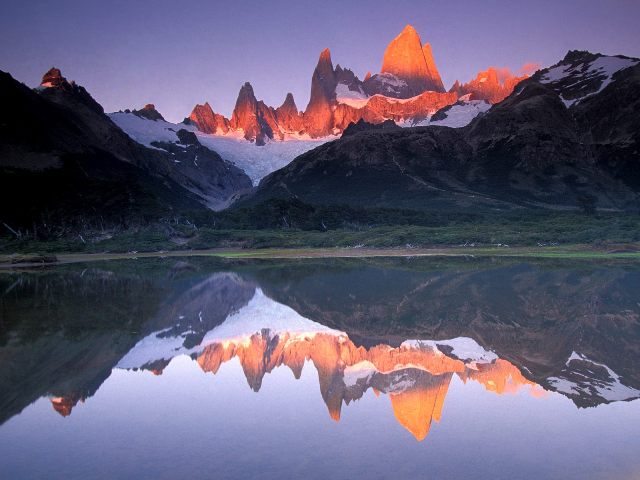
January 14, 2009, LAX-Buenos Aires:
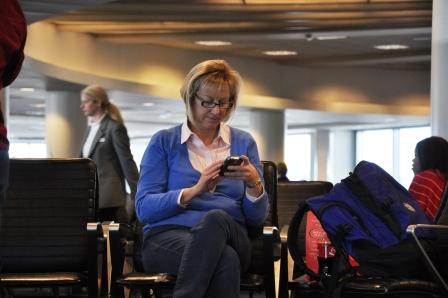
Cameron, who with Sarah and Brett are house sitting for us, drove us to LAX and we got there at 11:30 a.m. for our 1:40 p.m. on American Airlines to Dallas, where we met David. From there we boarded the international American Airlines flight from Dallas to Buenos Aires. That flight left Dallas/Fort Worth at 7:35 p.m. and arrived in Buenos Aires at 9:55 a.m. Our seats on the international flight were not too bad; just in front of a bulkhead in the middle of the airplane, with the two seats on the right side of the airplane in a 2-5-2 configuration. We had dinner on the airplane, watched a couple of movies on the seat-back monitor, and tried to sleep the sleep of a contortionist.
While it is summer in the Southern Hemisphere, and Buenos Aires is hot, we end up about 50 degrees south latitude, or about as far south as Alaska is north. While we will benefit from the long days, with the sun not going down until 11:00 p.m. or so, the temperatures will be in the high 60's in the days and in the 40's at night. We get to leave LA in 80 degree weather, carrying jackets, wearing long pants and boots. But we get to Southern Argentina in those same clothes, so we have to be a little warm right now.
January 15, 2009, Buenos Aires-El Calafate, Argentina:
Lisa and Mary met us just outside of the arrival gate and, after collecting our bags, we walked briskly over to the national terminal to see if we could get on an earlier flight to El Calafate. No such luck. We were able to check our big bags, and went back over to the main terminal to wait 3 hours for our flight time. Patty and I had missed out on breakfast on the airplane because the turbulence got too bad on the descent into Buenos Aires and they had to cut off service. We made up for it with overpriced airport coffee and sandwiches.
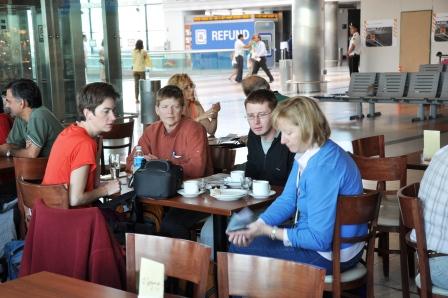
We then rested (all of us having flown overnight and were a bit tired by this point) and waited. We were not able to go through security until an hour before flight time, but we found a nice spot with seats and floor space.
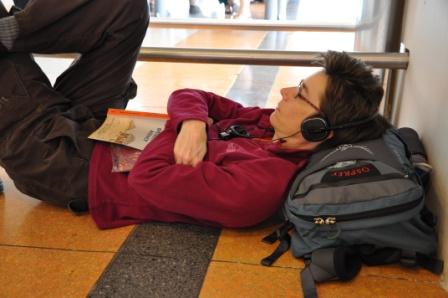
El Calafate is an established town that developed to support the cattle and sheep ranches on the Patagonian plain. As the Patagonian tourism industry has developed, El Calafate has become the hub where the major airport is located and where people who fly into the Argentinean Patagonia come first. While it is located near a large lake, which is fed by mountain streams coming off of the Eastern slope of the Andes, the town does not have much appeal itself. The Puerto Merino Glacier, one of the more impressive Andean glaciers which is reputed to still be growing, is about an hour away from town, but other than that it is mainly a place to go other places from. We are staying at the "Michaelangelo" Hotel, a reputedly nice place, where we should be happy to find any bed.
It was 33 degrees Centigrade (about 100 degrees Fahrenheit) when we got on the bus to go out to the remote airplane parking space for our flight from Buenos Aires. We climbed the stairs to the airplane and got in our seats. The air-conditioning was not on, and it was at least 100 degrees in the airplane, so we sat and sweltered for a half hour before the engine got started and it cooled off.
We flew 3 hours directly south. It was cloudy for the approach, so we did not get to see the mountains. We landed in wind and rain, but to my surprise, the little new terminal had one jet-way and we got to walk off of the airplane dry.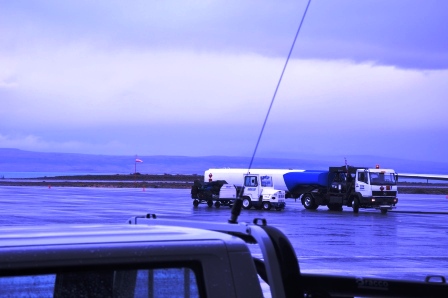
We collected our bags and got a couple of taxi's for the 20k ride into town. The Michelangelo Hotel is a nice, small one story place right in town and we got checked into our rooms and walked around town a bit on our way to the bus station to buy our tickets for the trip to El Chalten tomorrow.
After finding the bus station, we walked back and had a great dinner at the hotel restaurant, with good Malbec wine, steaks, pasta and lamb.
At 11:00 p.m., still light outside, we all got to sleep pretty quickly.
January 16, 2009, El Chalten, Argentina:
On Friday morning, we woke up greatly refreshed, and had breakfast at the hotel. Our shuttle bus that heads North around the lake and across the plains up to Los Glaciers National Park leaves at 1:00 p.m. The town in the national Park, which was created to service the Park in the 1980's, is pretty basic, with dirt roads, no cell phone coverage or ATM machines, but which is at the base of the Fitz Roy massive, and from which the hiking trails leave. There we are staying in a 7 room bed and breakfast. The Fitz Roy mountain is the one on the Patagonia clothing company logo.
The breakfast was good; juice, coffee (weak), tea, cereal, ham, cheese, breads, yogurt, etc. After we got packed up and checked out of our rooms (10:00 a.m. check-out time) we walked down to a grocery store and bought bread, cheese, ham, empanadas, cookies, crackers, fruit and wine for our lunches. We understand that the store here will likely be bigger than the El Chalten store, so we stocked up. Back at the hotel, we retrieved our bags, stowed our purchases and made the hike up the hill and across town to the bus station, were David and I watched the bags while the girls went back into town to shop and look around. A pirated internet connection let me surf the web and catch up on e-mail and work on the web site. At least today, the sky is clear, but it is a little cold, with lots of wind.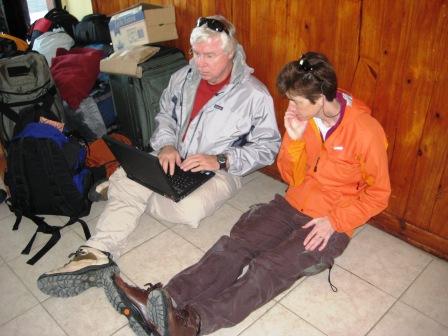
The bus we chose (all of which are run by a multitude of private tour companies), leaves here and takes three hours to get to El Chalten. Ours was prompt, and we loaded our bags in the belly and found seats. The bus was a modern tour bus with reclining seats and a television monitor that immediately showed an American movie called "Death Race" with lots of blood and car chases. The 20-something's in front of us seemed to enjoy it.
Since El Chalten is totally a climbing and trekking destination, with no local economy other than tourism, everyone on the bus was a tourist. Most visitors are young, European, fit and everyone is dressed like us in fleece, rain shells and hiking boots.
The ride is mostly over sage brush covered hills and around huge glacier-fed lakes. There are no trees and everything looks wind scoured. The wind was blowing about 40 mph, and you could feel it -- even in the bus. Looking out the window, I spotted some guanacos (cousin of what we recognize as the llama) and some ostrich-like birds. Other than that, it was pretty bleak. The trip followed Argentine Route 40, which runs on the east side of the Andes for a thousand miles or so. Most of the pavement portion on the highway is on our trip, and even the last 90 kilometers or so, after you turn off of Route 40 toward El Chalten, is now mostly paved. About 50 kilometers away from El Chalten, we began to see peeks of Fitz Roy through the clouds. Its sheer face looms over the low hills and towers up almost 10,000 feet above the low hills in front of it.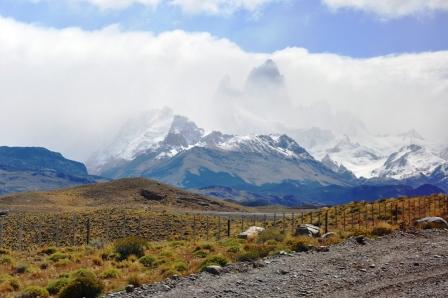
Our first stop in El Chalten is a mandatory introduction to the Park by the local ranger staff, where the group is led into the ranger station and then divided into Spanish and English sections, each to a room, with a short lecture on respect for the trails, camping regulations, etc. It is pretty much the same as you would get in a US national park, except that they do not charge any entry fee, or require permits for camping on the main trails. The only different part was a warning to hikers to discourage the town dogs from following us up the trails, because their presence scares the endangered small deer, and the dogs only want our food and we should not encourage them.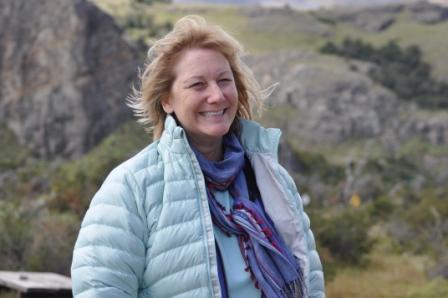
We found our 4-room hostel (Koonek Hosteria), and got settled in. It is nice, comfortable and has a popular rock climbing spot right out our back window. After settling in, we walked the town. They are currently paving the main street, so we can say we were here before the streets got paved, but not by much. We had to dodge the heavy equipment, as they worked through the dinner hour). The town now has its first ATM machine (brand new this year), but still no cell phone service.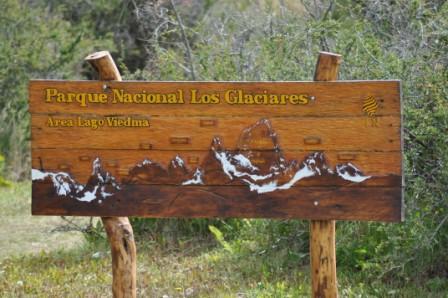
We spotted a pizza and homemade pasta place and stopped in about 5:30 p.m. for dinner. The pasta was adequate, the pizza and lentil soup were excellent, and we carbo loaded for the next day's hike. After dinner, we went to a climbing store and bought a good hiking map and a corkscrew, which I had failed to pack when we left the States. 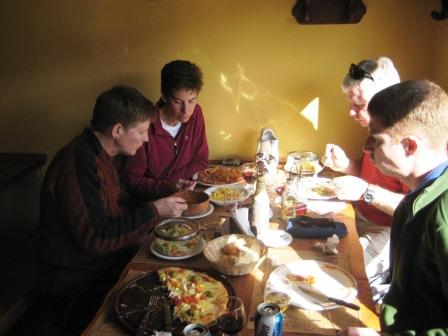
After a little shopping, we walked back to the Hostel and killed a bad bottle of wine in the room (even a $3 bottle of Malbec can be bad.) With the mountains blocking the sun, it was getting pretty dark by 10:30 p.m, so we called it a night.
January 17, 2009, El Chalten:
We were awakened about 6:00 a.m. by three guys, who climbed a short way up the rock climbing wall behind us and proceeded to sing bad songs in Spanish at the top of their lungs. They appeared to have stumbled out of a bar, and were greeting the day with boisterous serenades before they collapsed into a drunken slumber. Luckily, they got bored with that endeavor after about 15 minutes and wandered off.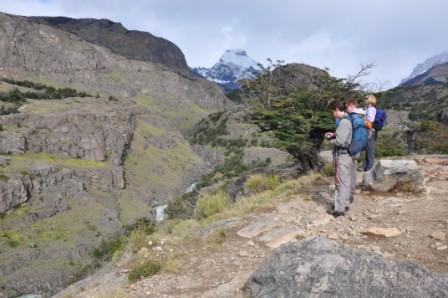
There were high clouds and a little wind, so it looked like a hiking day and we were all anxious to get on the trail. We were awaiting breakfast at the designated start time of 8:00 a.m. and all had coffee, juice, toast, and croissants, before bundling up and taking off. The temperature was in the 40's and there was a light wind. The clouds were spitting a little rain, but nothing serious. We found the trailhead by hiking up a dirt road skirting the upper edge of town, and climbed the hill over town, and dropped down a little into the top of the canyon that is made by the Rio Fitz Roy drainage. The trail follows the edge of this canyon up to Laguna Torre, or the lake at the base of the peak Cerro Torre.
Unfortunately, the peaks were in the clouds, where they remained the entire day. As we crossed the little ridge into the Rio Fitz Roy drainage, the wind calmed down and we were all reducing layers as we hiked and generated our own heat. The trail only gains about 500 feet over the 9 km (about 5.5 miles) hike to the lake, but there are lots of little ups and downs as the trail crosses small streams that feed off the side mountains into the Rio Fitz Roy river.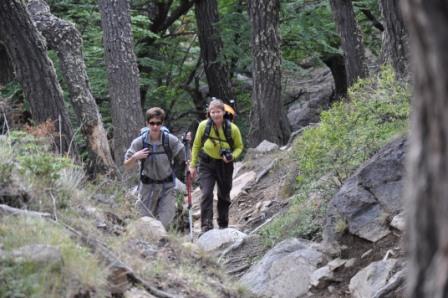
The trail starts off in fairly sparse vegetation, but as we moved up the valley, the Lenga (sort of a birch tree, with small flat leaves) forest got thicker and taller and we were often walking in a mossy, green forest. Between the little ridges, we walked through meadows and the trail gently rose along the path of the Rio Fitz Roy, a rolling river with the milky nature of a glacial-fed river. As the glacier slides down the rock base, it grinds the rock into fine powder, and the water off the glacier has a lot of this rock powder solution in with it, giving it the milky appearance. Some of the side streams coming into the valley were clear, indicating they came from melting snowfields higher up or from springs. One good thing is that since there are few mammals wild in this area, and the drainages are small, the streams have not been infected with Giardia and the water is generally safe to drink (unlike almost all streams in the North American and European mountains). 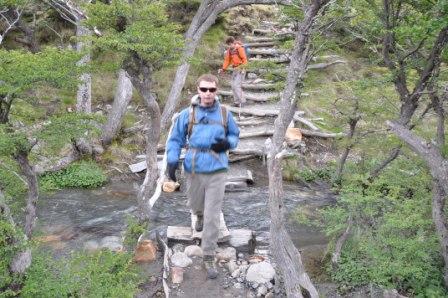
After about three hours of pretty steady hiking up the valley, we reached the terminal moraine of the glacier, which has created the lake, Laguna Torre. The moraine is just a big rock pile that the glacier pushes in front of it, and when it recedes, a lake often forms as the melt water drains from under the glacier and collects between the ice face and the moraine rock pile.
We walked through Camp De Agostini (formerly and on some maps still known as Camp Jim Bridwell, after the famous American climber), a large unimproved camp site near the river and on fairly flat ground under lenga trees. About 20 tents were spread around, mostly by people who had backpacked up from the valley and were spending a few days up in the mountains. We did not see any obvious climbing parties, but this is the base camp for those who are attempting Cerro Torre, the spire infamously known for the "compressor" route, where an Italian, Count Maestri, actually had a gas powered generator hauled up to a ledge where the face becomes pretty much vertical bare rock, and used it to drill bolt holes and install a rope ladder up the face. He was unable to get through the snow mushroom that caps the summit, but claimed a first ascent anyway. His "industrial" style made the climb not only unsporting, but his failure to get on the actual summit made the climb very controversial and the first climbers who actually got through the snow mushroom are generally credited with the first ascent.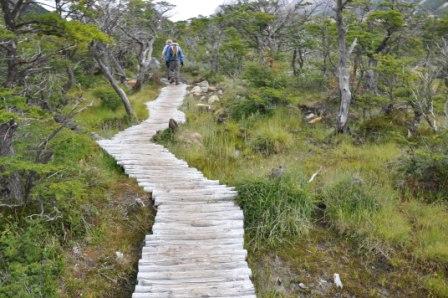
After gaining the top of the moraine, with a nice view of the lake, we stopped for lunch. It was still about 40 degrees, so we bundled up and ate our sandwiches and enjoyed the view. Mary hiked a little further around the lake, but the rest of us started down the hill to the trail and headed back for town. Mary quickly caught up with us back down the trail a ways.
As we got further down the trail, the sun came out, the temperature jumped 15 or 20 degrees, and we were soon stripping off layers again. As we got lower, we saw more of the "jeans and tennis shoe" crowd, heading up the trail after having made a much more civilized start time. I am not sure how far most of these people made it, but there are nice view points on the intermediate ridges that would have made the hike worthwhile even if they did not get all the way to the lake. While the clouds never cleared from the peaks, we got a few glimpses of the ridgelines as the clouds moved through. 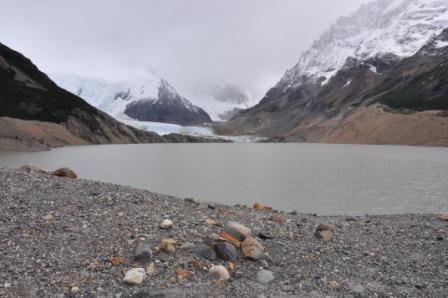
We finally got to the ridge overlooking town and decided that the proper course of action was to stop by the only brewpub in town and drink some beers before heading back to the Hostel. We managed to drop into town at the right block and found the brewpub, and happily drank some local pilsner, with spinach empanadas and free popcorn. The hike covered about 11 miles and took us about 7.5 hours. We were pretty much in line with the posted hike times on the trail signs, so we felt we had done well.
When we got back to the room, we all immediately took a nap and then opened a bottle of wine (a better Malbec this time). Lisa and Mary took off for an internet cafe and Patty, David and I went to a "Bistro" favorably listed in our Lonely Planet guidebook. It turned out the food was great and reasonably priced. We had steak, trout, salads and, after Lisa and Mary wandered in, a dessert platter with a selection of all their desserts. We felt like we could afford the calories.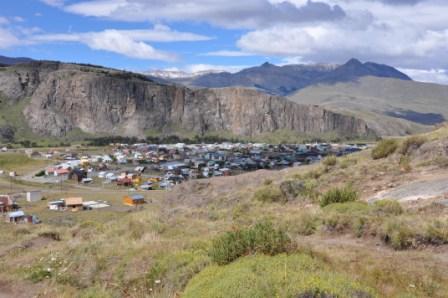
We got back to the Hostel about 10:00 p.m. and it did not take long to get to sleep.
January 18, 2009, El Chalten:
After a good night's sleep, we woke up, sans serenades, had breakfast at the Hostel and walked around town for a little while looking for an internet cafe that would allow me to plug in the laptop to their connection (necessary to update the website.) I found one not too far from the Hostel and the rest of the group went looking for sandwiches for a hike today.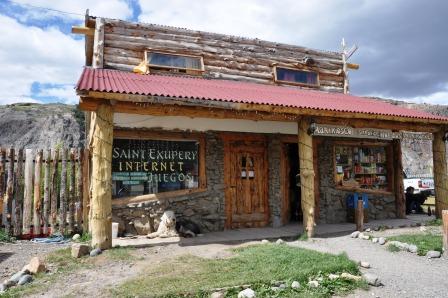 The wind is howling so we may stay fairly close to town.
The wind is howling so we may stay fairly close to town.
Yesterday, I saw some unshod hoof prints on the trail, which is unusual because pack animals usually have horse-shoes on. Today, I figured out what they were, when I saw a llama pack train going by our Hostel this morning.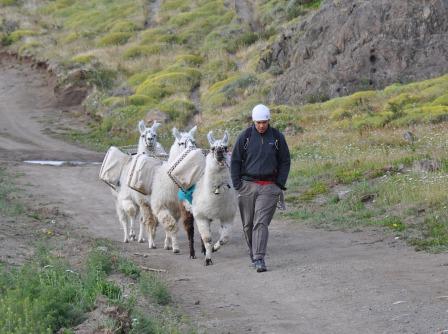 After we had done our errands, we met back at the Hostel and readied ourselves for the day. We took off about noon and hiked down through the town to the ranger station, and did a hike up the hill behind the ranger station onto a high bluff with great views both over the town and to the mountains. Fitz Roy was mostly out of the clouds, so we got a lot of good pictures.
After we had done our errands, we met back at the Hostel and readied ourselves for the day. We took off about noon and hiked down through the town to the ranger station, and did a hike up the hill behind the ranger station onto a high bluff with great views both over the town and to the mountains. Fitz Roy was mostly out of the clouds, so we got a lot of good pictures.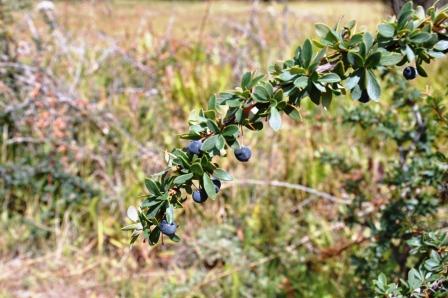
The town we flew in to ("El Calafate") is named after an indigenous berry that grows wild here and is a lot like a blueberry. The Hostel has calafate bushes out front and they grow wild on the hillsides. A local ice cream shop sells calafate ice cream. It has large thorns and small leaves, and seems well-suited to this harsh environment.
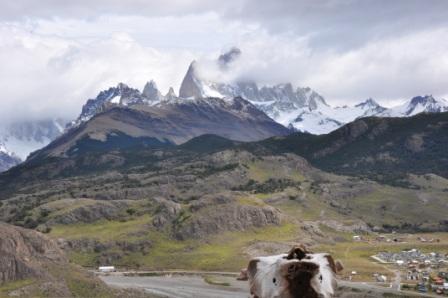
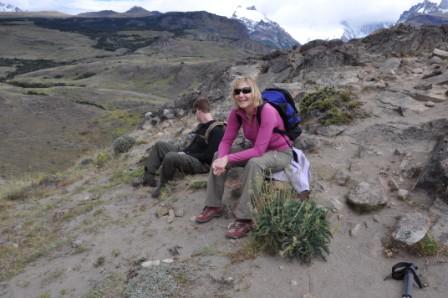
The trail went up to the bluff over the ranger station, and then another branch led over the hill to a view down to the east, over Lago Viedma, the large glacial lake that stretches off across the pampas for dozens of kilometers. The terrain is somewhat similar to the eastern Sierra in California, with the mountains to the west and a dry desert to the east. After about three hours of hiking, we got back to the trailhead and David, Lisa and Mary took another spur that went mostly south up the ridge on the other side of the Rio Fitz Roy river. Patty and I headed back to town; she caught up on e-mail at the internet cafe and I bought a huge beer at the store next door and pretended to re-hydrate myself back at the Hostel.
Dave, Lisa and Mary came in a couple of hours later, and we went out to a close-by dinner (as Lisa's knee was hurting); unfortunately, not up to the quality of food that we got last night. We made plans to get up early the next day and head for the Laguna de los Tres trail at the base of Fitz Roy tomorrow. We are hoping for more sun and less wind tomorrow.
January 19, 2009, El Chalten:
We were all up early and at the breakfast table by our pre-arranged start time of 8:00 a.m. for our breakfast of cold, dry toast, juice, coffee and hockey puck biscuits with jam. Mary had already been down to a bakery to buy her and Lisa sandwiches for the day, and reported that (1) Fitz Roy was standing proud and cloud free; and (2) it was "hot."
I made sandwiches from the last of the groceries we had bought in El Calafate (except that we had bought fresh bread here in town last night). We were all breakfasted, packed and ready and out the door by 9:00 a.m. We were in shirtsleeves per Mary's recommendation, and none of us were sorry because it was the warmest we had seen since we have been here. The trailhead was about 4 blocks up the street, at the north end of town, and we reached it quickly. 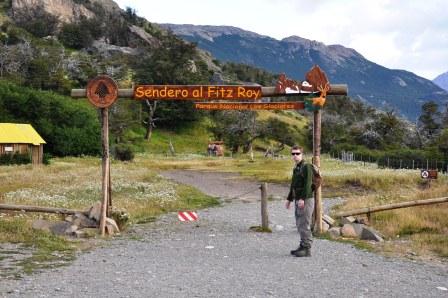
The trail climbs steeply up the hill behind town, and generally parallels the river valley, while gaining altitude on the hillside. Winding through a lenga forest, with horses grazing on the grass, the trail opens up occasionally with views up the river valley over the estancias, or ranches the original settlers pioneered in the river valley. Once in the forest, and up the hillside a little ways, we were protected from the ever present wind.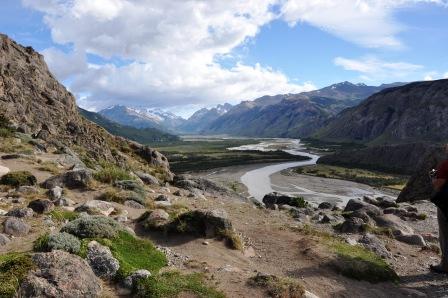
After reaching a plateau at the top of the climb, the trail crests a hill and then forks one way to Lago Capri, a mountain lake, or toward a view overlook. We chose the view and promised to take the lake branch on the way back, since they both connect on each side of the trail. We came over a gentle crest, and to a rock outcropping, where the views of Fitz Roy were spectacular. 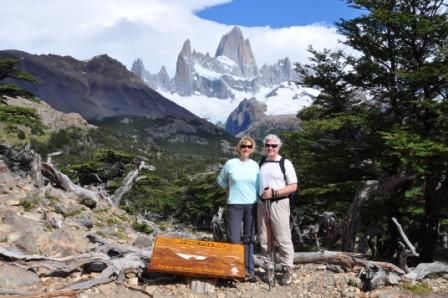
The trail then dropped gently into the drainage valley from the Fitz Roy massif and wound its way up the valley past several other trail junctions and then across several streams up to Camp Poincenot, named after the peak which is the left-most prominent peak in the Fitz Roy massif. Poincenot was a member of the French climbing expedition, led by Lionel Terray, that succeeded in putting two climbers, including Terray on the summit of Fitz Roy in early February of 1952. Poincenot himself died trying to cross the Rio Fitz Roy river, when he slipped and was then held under water at the knotted end of his safety rope. Mary pointed out that if that is all it takes to get a peak named after one-self, she could do that. After going through Camp Poincenot, which is the trekker campsite, we then crossed the river on a precarious log bridge,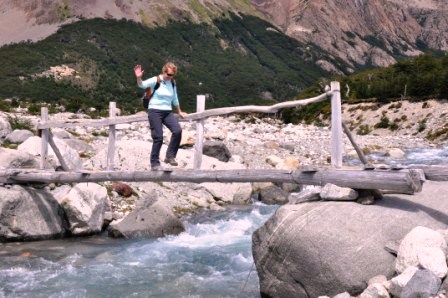 and hiked up to the climber's camp, which is at the base of the trail up the terminal moraine to Laguna de los Tres, the lake just below the peaks. At that point, we were 10 kilometers from the trailhead and still a thousand feet below the lake. We stopped for lunch and a personal physical inventory to see if we each felt strong enough to continue up to the lake.
and hiked up to the climber's camp, which is at the base of the trail up the terminal moraine to Laguna de los Tres, the lake just below the peaks. At that point, we were 10 kilometers from the trailhead and still a thousand feet below the lake. We stopped for lunch and a personal physical inventory to see if we each felt strong enough to continue up to the lake.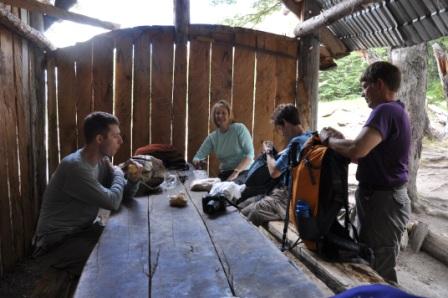
After lunch, and a short walk around the climber's camp, where at least I felt like I was walking on holy ground, as this is where some of the world's best alpine climbers hang out, we all felt strong enough to attempt the steep, exposed, switchback trail up to Laguna de los Tres. David and I led out, and it took us about 50 minutes to climb the 1000 feet, but we were rewarded with a spectacular view at the top. A few minutes later, Lisa led Mary and Patty up over the rocks and we took lots of pictures, sat down and drank to try to recover from the climb and prepare for the descent.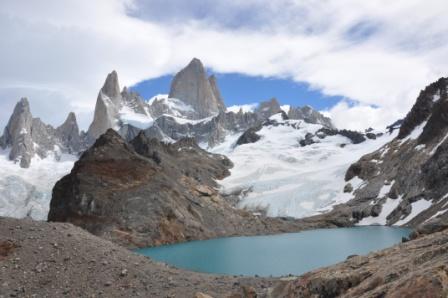

The descent back to the campground was almost tougher than the climb to the top. We left the high point at 3:00 p.m., after having been on the trail for 6 hours already, knowing that we had another 4 hours or so until we were back in town. We trudged on, Patty, David and Frank in the first group, and Lisa and Mary taking it slow. The first group made it off the trail about 7:30 p.m., with David going ahead and meeting us at the trailhead with a cold beer. (Nice touch!!) We stopped at the first restaurant, all of us in varying degrees of pain from pounded feet. As we were eating, Lisa and Mary came in and we all sat together and compared stories of a remarkable day.
January 20, 2009, El Chalten:
As were were leaving the peak yesterday, the clouds were starting to lick the peaks and it spit a little rain on us near the end of the trail. This morning, we awoke to wind, clouds and steady rain. It looks like our timing on the hike yesterday was impeccable. Today is Inauguration Day and we are hoping to find a television to watch the ceremony. There is a television in the breakfast room here, with satellite TV, so we are hopeful. It will be a good day to recover anyway.
David, Lisa, Mary and I walked down to a waffle place and had waffles for breakfast, and by the time we finished, the rain had stopped and the sun was coming out. We bought some chocolate "pudding" (a moist cake) and took it back to Patty at the Hostel. She was not interested enough in breakfast this morning to take a walk in the rain.
As soon as we got back, I turned on the TV in the breakfast room and found CNN in English and started watching their continuous coverage of the inauguration. I do not think I have ever watched an inauguration before and I was fascinated by the traditional activities associated with the event. I sat glued to the TV while others came and went. I brought out a bottle of water, some cheese and salami left over from the trail, and watched every minute of the traveling to the Capitol Building, the introductions, the swearing-in ceremony, the program, address, poetry reading, prayers, and the Bush send-off. I thought President Obama's address lived up to or exceeded expectations. I am really opportunistic about his ability to heal divides and in his words -- "break down tribalism and realize our common humanity." 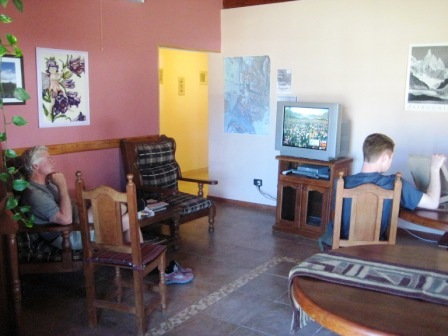
Lisa and Mary walked down and bought a pizza and brought it back for everyone. They signed up for a tour on a mini-bus up the valley to a large lake at the head of the valley. Patty, David and I left the Hostel about 4:00 p.m. and walked around town, down to the newly installed ATM, where we were able to restock on cash, and then shopping. We went for an early dinner (6:00 p.m. here is quite unfashionably early) at a place called Patagonicus; a very upscale restaurant on the way into town. It is funny that while the restaurants vary from very basic with wood benches to places like this with table clothes, fine water and wine glasses, and very professional wait staff, the prices seem to be about the same everywhere. Wine is not marked up terribly in the restaurants (about 2 times the store price) so we always order bottles of wine with dinner. We had steaks, pasta, salads, rolls, several kinds of potatoes and everything was very good.
Lisa and Mary got back from a nice trip after we had gone to bed at about 11:00 p.m., and Patty went out to talk with them. David and I stayed under our covers.
January 21, 2009, El Calafate:
We got up early to catch our 8:00 a.m. bus back to El Calafate. The Hostel gave us breakfast earlier that usual and we headed off for the bus pick-up location by 7:45 a.m. When we got there, most of the bus load was already in line to get on the bus, so we stowed our luggage and picked-up the end of the line. The crowd is predominantly 20-somethings, traveling in pairs. There is the usual backpacker melting pot of nationalities, dominated by Europeans, but the odd Brit, Kiwi, etc., thrown in. A few Americans and an occasional Asian.
The bus left promptly at 8:00 a.m. and we started down the road east out of town. It is the clearest day we have had here and we finally got to see the Cerro Torre massif from the bus. The road runs east, along the north shore of Lago Viedma, the large glacial lake that stretches east from a snout of the ice cap that pierces the mountains a few kilometers south of El Chalten. It looks barren with just sage brush and bunches of grass, but if you watch intently out the bus windows (most people have their iPods in their ears, their curtains drawn and their seats reclined) there is the occasional surprise; an ostrich trotting over the sage, pink flamingos in a pond, black neck swans in another pond, or a stream running from some unseen spring in the hills surrounding the valley.
Like the Calafate berry, the seemingly barren pampas have a rich life adjusted to the harsh conditions. Like the Jeff Goldblum character says in Jurassic Park: "Life always finds a way." As I am typing this, the bus is bumping across the last unpaved section of the road leading to Route 40. You can still see the Fitz Roy and Cerro Torre massifs 60 kilometers off in the distance across the broad expanse of Lago Viedma, and to the other side, the spring flood river winding its way to the Atlantic ocean from the Lago Viedma outlet. In an occasional green spot, you can spot an estancia with its eucalyptus trees reaching skyward in an attempt to block the incessant Patagonian winds, and pens for a few horses and for collected sheep for shearing and butchering.
We got to El Calafate and walked across town for 9 blocks, over the creek, and through the woods, and found "Casa del Grillos," our bed and breakfast with the nicest owners, who made sure to tell us that we would have breakfast waiting for us at 5:00 a.m. so we have time to eat before our bus to Chile and Torres del Paine tomorrow morning.
After checking in and going to our clean, large and comfortable rooms, we grabbed stuff for this afternoon and headed back up to town to eat and catch our 2:00 p.m. tour bus to the Moreno glacier. We found a buffet run by some Chinese people; sort of your typical Chinese/Argentinean buffet with grilled steak, sausages, egg rolls, chow mien, potato salad, etc. It was pretty eclectic, but cheap, good and fast.
The Moreno Glacier is about 50 kilometers out of town and is the big tourist draw for the southern end of Los Glaciers National Park.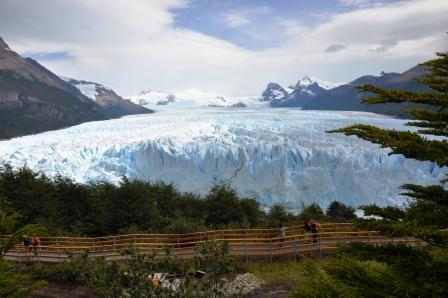 I initially thought, having spent many weeks of my life on glaciers, I could miss it. I went along for the ride, since everyone else wanted to go out and see it. It turned out to be well worth the trouble and expense. It is one of the ice rivers that makes its way east off of the Patagonian Ice Cap, and empties into Lago Argentina, just as the Viedma Glacier empties into Lago Viedma further north. What makes this glacier special is that it runs smack centered into a large, strong hill, which lifts the glacier in the middle, making it break apart in thousands of ice spires, and crosses a branch of the lake, with large parts of the lake on each side of the tongue of the glacier. The glacier ends up with the water making a tunnel in the tip of the tongue, lateral to the flow of the glacier, and the spires collapsing into the water. Walking paths constructed on the hillside get you to about 50 meters in front of the glacier, and both the state of the glacier and the near constant calving of ice into the lake make for a spectacular show.
I initially thought, having spent many weeks of my life on glaciers, I could miss it. I went along for the ride, since everyone else wanted to go out and see it. It turned out to be well worth the trouble and expense. It is one of the ice rivers that makes its way east off of the Patagonian Ice Cap, and empties into Lago Argentina, just as the Viedma Glacier empties into Lago Viedma further north. What makes this glacier special is that it runs smack centered into a large, strong hill, which lifts the glacier in the middle, making it break apart in thousands of ice spires, and crosses a branch of the lake, with large parts of the lake on each side of the tongue of the glacier. The glacier ends up with the water making a tunnel in the tip of the tongue, lateral to the flow of the glacier, and the spires collapsing into the water. Walking paths constructed on the hillside get you to about 50 meters in front of the glacier, and both the state of the glacier and the near constant calving of ice into the lake make for a spectacular show.
After hanging out there for about 4 hours, we rode the bus back to town and David, Patty and I found a good place for dinner, with fresh salmon, skewers of fresh beef and vegetables, and ravioli, all well prepared and served. After dinner we stocked up on inexpensive wine and liquor before our foray into Chile and the expensive hotel. We actually walked back to the B&B in the dark; a first for us on this trip (since it requires that you be out after 11:30 p.m., and it be cloudy at that).
It is now midnight, so pictures will have to follow later.
January 22, 2009, El Calafate to Torres del Paine, Chile:
We got up at 4:30 a.m. to get showered, packed, fed and ready for the bus pick-up at 5:45 a.m. A 12 passenger van picked us up right on time and loaded us with others already on the bus. We drove through town, picked up a few other people, and drove out of town. Just past the guard house at the edge of town, the 12 passenger van pulled in behind a large double-decker tour bus and we were told to transfer vehicles, while drivers put our luggage under the big bus. We got aboard, found seats in the upper deck, and settled in. The bus took off across the sage brush and bunch grass "estepa" and we all went back to sleep. About 3 hours later, we turned off of the paved road and proceeded west on a rough dirt road for a few miles, until we came to the Argentine border station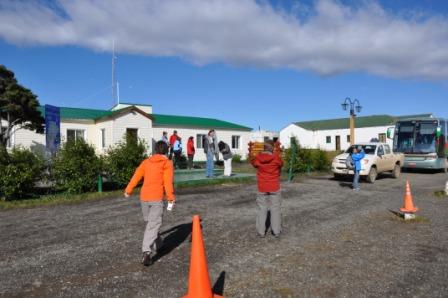 , where a chain across the road stopped our progress. The bus driver collected our passports (except for the poor girl in front of us who realized she had left it in her room back in El Calafate). Her and her boyfriend got off and went into the office. A little while later they appeared, and a nice couple heading the other way made room in their back seat to take them back to Calafate, 3 hours away.
, where a chain across the road stopped our progress. The bus driver collected our passports (except for the poor girl in front of us who realized she had left it in her room back in El Calafate). Her and her boyfriend got off and went into the office. A little while later they appeared, and a nice couple heading the other way made room in their back seat to take them back to Calafate, 3 hours away.
After 30 minutes, we were cleared to leave, Argentina, our passports stamped and handed back to us. The bus then proceeded a couple of miles down the road to the Chilean border station, where we had to collect our bags, and get in line to be cleared into Chile in a small office building. 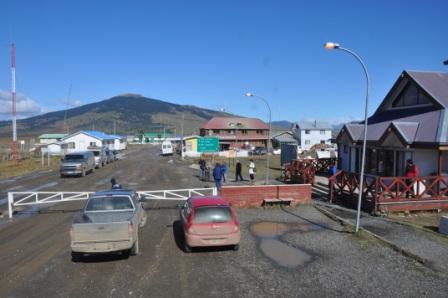 There we met our guide for Chile, Luciano, who told us to meet him in the cafe next door after we were cleared in. We had to stand in a long line, have our baggage hand-searched and a visa issued. After clearing through that, we walked on to the cafe, where we met Luciano, and where the 3rd bus of the day awaited us. It took from 10:00 a.m., to 12:30 p.m. to get everyone cleared by the Border Patrol. The people on a one-day tour were put in one bus and (we who were staying) in another bus. These were the 12 passenger variety again, so it was a smaller group leaving.
There we met our guide for Chile, Luciano, who told us to meet him in the cafe next door after we were cleared in. We had to stand in a long line, have our baggage hand-searched and a visa issued. After clearing through that, we walked on to the cafe, where we met Luciano, and where the 3rd bus of the day awaited us. It took from 10:00 a.m., to 12:30 p.m. to get everyone cleared by the Border Patrol. The people on a one-day tour were put in one bus and (we who were staying) in another bus. These were the 12 passenger variety again, so it was a smaller group leaving.
The bus then trundled down the dirt road, and Luciano pointed out birds, plants, and guanacos,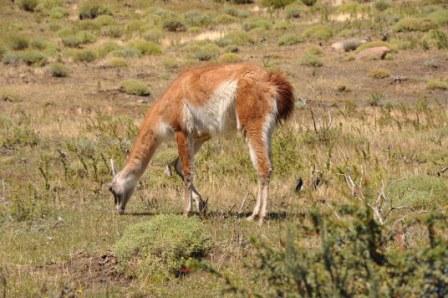 and we even stopped to take pictures of guanacos and an ostrich which was trotting along the road-side at the fence. A few miles down the dirt road, we came to our first view of the Torres del Paine peaks. It is a relatively small set of mountains, and one trek completely circumnavigates the range in about 8 days. We drove past a number of lakes, saw abundant wildlife, and stopped for a few pictures. At the Park entrance station, we turned in our registration, along with about $25 each in Chilean money that we had to exchange at the cafe, and got back our Park pass. At this stop, the river at the bottom of the hill had overflowed its banks, and backpackers were wading across the flooded river which extended beyond where a bridge covered the deepest part of the river. We were looking on in amazement, watching them until looking at a map posted at the entrance station made it clear that this was also the route to our hotel!
and we even stopped to take pictures of guanacos and an ostrich which was trotting along the road-side at the fence. A few miles down the dirt road, we came to our first view of the Torres del Paine peaks. It is a relatively small set of mountains, and one trek completely circumnavigates the range in about 8 days. We drove past a number of lakes, saw abundant wildlife, and stopped for a few pictures. At the Park entrance station, we turned in our registration, along with about $25 each in Chilean money that we had to exchange at the cafe, and got back our Park pass. At this stop, the river at the bottom of the hill had overflowed its banks, and backpackers were wading across the flooded river which extended beyond where a bridge covered the deepest part of the river. We were looking on in amazement, watching them until looking at a map posted at the entrance station made it clear that this was also the route to our hotel!
Our tour continued on into the Park, and we saw about all that could be seen from a car, and even got out for some short hikes. The wind was howling, so we had to brace ourselves and wait between gusts to take pictures of the spectacular scenery. The last tour stop was the Park Administration building, where Lucian used a relief map of the Park to show us the various trails and activities. 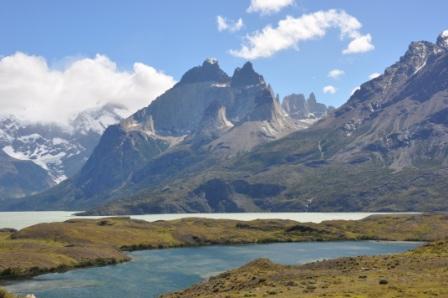 We then got back to the park entrance station, wondering how we were going to get across the river. As we got there, a stake-bed farm truck was loading people and baggage to ford the river. We clambered aboard, after having stacked our luggage in the back, and it was standing-room only in the back. The sides had "fences," but the back had only a rope stretched across. We all had our cameras out as the truck bounced through the 2 foot of water over what once had been the road, heading for the bridge. We got to the bridge and the truck cleared the sides with only a couple of inches to spare on each side. Over the bridge, and up the other bank, we climbed down from the truck bed, loaded our luggage and selves into a Las Torres shuttle van for the 7.5 kilometer trip up to the hotel.
We then got back to the park entrance station, wondering how we were going to get across the river. As we got there, a stake-bed farm truck was loading people and baggage to ford the river. We clambered aboard, after having stacked our luggage in the back, and it was standing-room only in the back. The sides had "fences," but the back had only a rope stretched across. We all had our cameras out as the truck bounced through the 2 foot of water over what once had been the road, heading for the bridge. We got to the bridge and the truck cleared the sides with only a couple of inches to spare on each side. Over the bridge, and up the other bank, we climbed down from the truck bed, loaded our luggage and selves into a Las Torres shuttle van for the 7.5 kilometer trip up to the hotel.
Arriving, the bell boy came out and took our dusty bags into the lobby and we checked in. The hotel is relatively small, and surrounded by grass that is kept short by grazing horses. A little way up the road is the campground for people who are camping, also in a grass field, under trees, with a pretty stream running through it.
Checked in, it was 8:00 p.m., so we immediately took our dusty and windblown selves to the hotel restaurant and all ordered the "set" menu, including salad bar and dessert. The food was, as David described it, like mediocre wedding food. It ranged from boring and mediocre (the steak) to really bad (the salmon encrusted in sesame seeds.) We got a relatively cheap bottle of Malbec, and the bill came to about $45 per person (on the bill as US Dollars and Chilean Pesos: 600 to the dollar.) We charged it to our room, vowed not to order the fixed menu again, and perhaps not even eat there again (a hard thing since nothing else is within about 20 miles).
We were all exhausted, so we crashed early, after a short trip out to a snack kiosk at the start of the trail, also run by the hotel.
January 23, 2009, Las Torres Hotel, Torres del Paine National Park:
We got up about 8:00 a.m. and went to the breakfast, included in the $340 per night room charge, not expecting much, and were wildly surprised. They had fruit, eggs, cereal, yogurt, meats, cheeses, pancakes, coffee, hot chocolate, milk, breads, and about every thing you could have hoped for. It was about as good as dinner was bad. We loaded up our plates and surreptitiously made sandwiches for the trail.
About 10:00 a.m. we started the trail to the Torres del Paine view point at the base of the granite towers that give the Park its name. It was a similar distance and elevation gain as the Fitz Roy hike, so we thought we knew what we had in store. However, the Chilean Park Service trail construction and maintenance could learn a little from the Argentines, and the trail conditions were pretty bad, with streams running down the trails, multiple branches, poor signage, and terrible grades and descents. The trail looked as if it had just "happened" and not as if it had been engineered or planned. Lisa and Mary had taken off before us, so we kept expecting to catch them on the trail, as Lisa had a gimp knee. 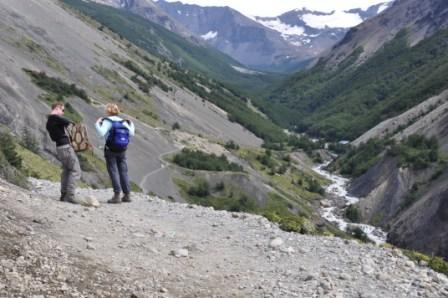
After about 3 hours we came to the first "Refugio" or trail hostel and campground. These are on all of the trails, and you could, in theory and if you were able to reserve them all in the right order, do the grand circuit sleeping in a bunkhouse and eating Refugio food for every meal. At this stop, we were able to fill our water bottles and rest a little.
Once again, the weather cooperated, and the day turned out to be sunny and almost windless. Quite a difference from the 40 knot gusts we dealt with the day before. About 2:30 p.m., we got to the base of the towers, where we finally found Lisa and Mary. They had made it all the way up ahead of us, even given the miserable trail conditions and the final 500 vertical feet of boulder scrambling with no trail at all, just painted blazes on an occasional rock on the way up. The view was stunning and we took pictures, drank water and ate our sandwiches "stolen" from the breakfast spread this morning.
After about a half hour, we headed down, managing not to fall off a boulder, and get to the trail at the bottom of the canyon. Refilling our water bottles at the Refugio again, we trudged on and made it back to the hotel, footsore and tired at about 6:30 p.m. -- about 8 and a half hours of hiking.
We took showers (the hotel has lots of hot water, and good water pressure--for the first time on the trip) and met in the bar. We negotiated with the guides to do a Hotel trip to the French River Valley tomorrow, Patty getting us 10% off of the regular price for 5 people.
We went back to the restaurant and just ordered the salad bar and stuffed ourselves for half the price of the full dinner menu. Then we sped off to bed.
January 24, 2009, Las Torres Hotel, Torres del Paine National Park:
We met the opening of the dining room at 7:00 a.m. and ate breakfast early so as to be on time for our 8:00 a.m. meeting time with our guide, Juan. 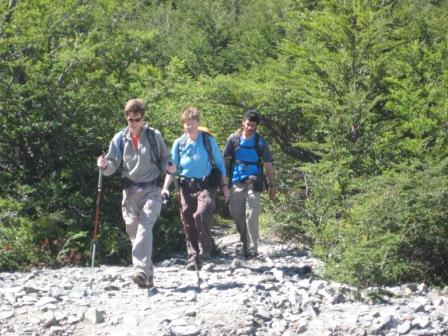 He met us with each of our lunches in a paper bag; which consisted of an apple, sandwich, cereal bar, trail mix, apple juice and a bottle of water. We stowed those in our backpacks and headed out to the van for a trip down to the river crossing, where we changed vans after crossing a lower river in the first van. An hour trip got us to the Pehoe Lake where a 50' steel catamaran has been trucked in and put in the lake.
He met us with each of our lunches in a paper bag; which consisted of an apple, sandwich, cereal bar, trail mix, apple juice and a bottle of water. We stowed those in our backpacks and headed out to the van for a trip down to the river crossing, where we changed vans after crossing a lower river in the first van. An hour trip got us to the Pehoe Lake where a 50' steel catamaran has been trucked in and put in the lake. 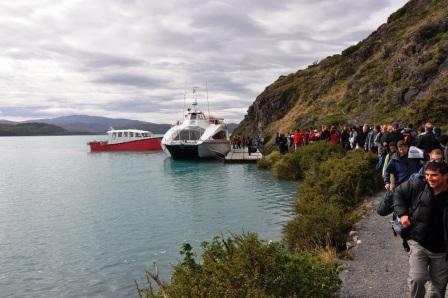 It takes passengers for a half hour ride up the lake, in a road-less area of the Park, where there is a small hotel or "Refugio," a campground and a ranger station. From there, we started our hike about 10:00 a.m. toward the French River Valley, at the base of the "Horns."
It takes passengers for a half hour ride up the lake, in a road-less area of the Park, where there is a small hotel or "Refugio," a campground and a ranger station. From there, we started our hike about 10:00 a.m. toward the French River Valley, at the base of the "Horns." 
Juan led a fairly brisk pace on an increasingly poor trail, which wound up and down over rolling terrain around the edge of several lakes on the way to the mouth of the valley. After a couple of hours, we reached Camp Italiano, a campground just after a suspension bridge over the French River. 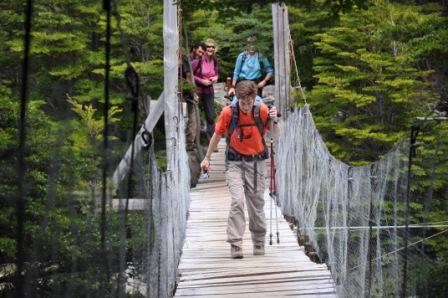 The camps are named after climbing base camps where historic climbing expeditions established base camps from whence to launch assaults on the peaks. Up the valley is the "British" camp, where Chris Bonnington, the leader of a British expedition established his base camp, from which most of the peaks and spires were first climbed. At the Camp Italiano, we turned directly up the valley and climbed up a trail, which degraded into boulder hopping, until we found a good place for lunch on some sunny rocks (which turned out to house at least one hungry mouse). Juan brought a thermos of coffee and we all had hot coffee after lunch and took some pictures.
The camps are named after climbing base camps where historic climbing expeditions established base camps from whence to launch assaults on the peaks. Up the valley is the "British" camp, where Chris Bonnington, the leader of a British expedition established his base camp, from which most of the peaks and spires were first climbed. At the Camp Italiano, we turned directly up the valley and climbed up a trail, which degraded into boulder hopping, until we found a good place for lunch on some sunny rocks (which turned out to house at least one hungry mouse). Juan brought a thermos of coffee and we all had hot coffee after lunch and took some pictures.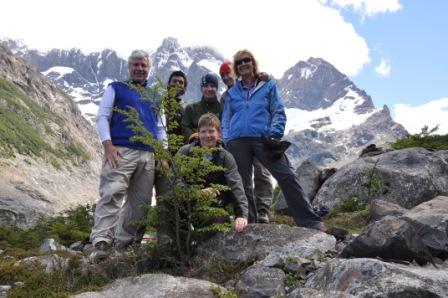
Juan was good at identifying birds, insects and plants and we got a good education on the flora and fauna. He is from Santiago, but has been guiding here in the Park for three years. The summer is the busy season, but he stays here year-round. There is no nearby town, so all of the hotel employees also live on the grounds.
A couple of hours on muddy, rocky trails, got us back to the Refugio at the base of the climb, and the bar with a great view of the "Horns." We went through 3 rounds of beers waiting for the boat. When it was on the horizon, Juan rounded us up and we walked down to the dock and got in line. 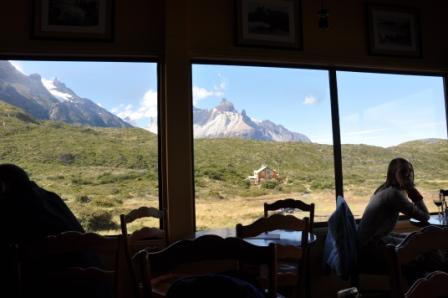 Unfortunately, the crowd was too large for the boat, so they split the group in half and told us (at the back half of the line) that we had to wait for the boat to make a second trip, or another hour wait. We walked back up to the Refugio and got in line for the chicken dinner, and had dinner in the cafeteria while we waited for the catamaran to return. We finally made it back to the hotel at 9:30 p.m., downed a bottle of wine and went to bed after a long day.
Unfortunately, the crowd was too large for the boat, so they split the group in half and told us (at the back half of the line) that we had to wait for the boat to make a second trip, or another hour wait. We walked back up to the Refugio and got in line for the chicken dinner, and had dinner in the cafeteria while we waited for the catamaran to return. We finally made it back to the hotel at 9:30 p.m., downed a bottle of wine and went to bed after a long day.
January 25, 2009, Las Torres Hotel, Torres del Paine National Park-Calafate:
We took our time this morning getting up and getting to breakfast; the only time time pressure being a 10:00 a.m. breakfast closing, a noon check out time and a 4:00 p.m. transfer to the entrance station to catch the bus back to Calafate, Argentina. 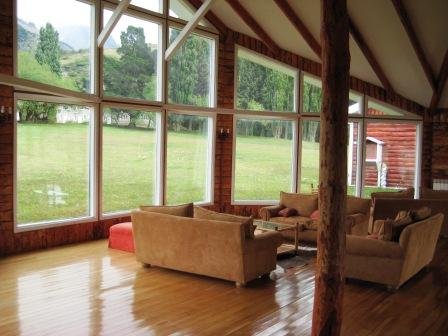 After breakfast and packing our bags, I took a walk on a little used 2.5 km nature trail, David read a book, Patty caught up on e-mail and spent a while proofing and editing the web-site, Lisa got a massage at the spa, and we all just lazed around. It is windier and a little rainy today, so it is a good day to just hang out, and given the pace we have been going at, it is nice to have an off day, especially since the hotel has a lot of common areas with big, soft couches, fireplaces and big picture windows.
After breakfast and packing our bags, I took a walk on a little used 2.5 km nature trail, David read a book, Patty caught up on e-mail and spent a while proofing and editing the web-site, Lisa got a massage at the spa, and we all just lazed around. It is windier and a little rainy today, so it is a good day to just hang out, and given the pace we have been going at, it is nice to have an off day, especially since the hotel has a lot of common areas with big, soft couches, fireplaces and big picture windows.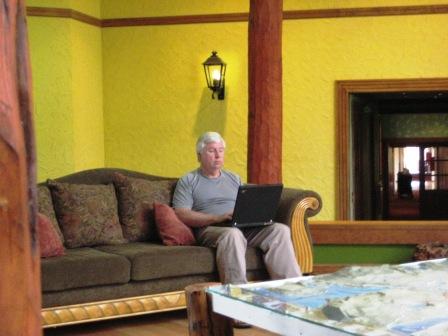
We are supposed to catch our tour bus back to Calafate at about 4:30 p.m. at the Park entrance station, where we will take the small bus back to the border and hopefully (after clearing out of Chili and back into Argentina, get the bigger bus for the three hour tour back to Calafate. We are staying at the same B&B we stayed at last time, but we will get in late. Our flight to Buenos Aires is tomorrow morning about 10:00 a.m., and gets us into Buenos Aries a little after noon. Patty, David and I are then going to a hotel, and Lisa and Mary transfer to the international airport for their late night flight back to the USA.
The trip has gone fast and we have seen lots of spectacular country. It is not a trip where we have seen a lot of the local culture because we have been in such isolated areas, mostly with other trekkers, hikers and climbers, that we have not seen much "normal" life. However, we have met a lot of interesting people from all over the world and had a great time.
January 26-27, 2009, Mine Hotel, Buenos Aires, Argentina:
Our transfers all worked out; the water had receded and we were able to ride across the river in the van, the bus found us at the Park entrance station, the border crossings went according to plan and we got into El Calafate at about mid-night. The B&B owner was up to greet us, and we quickly got to bed. We were able to sleep until about 8:00 a.m., had a shower and a good breakfast, and took taxi's to the airport where we checked in with no problem. 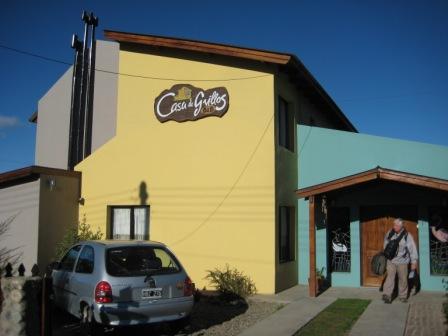 The only irritation is the insistence of a lot of third world countries, including Argentina, to charge an exit tax, which is not added onto the airfare, but requires standing in a separate line to pay the tax, which gets the boarding pass stamped. The security guy confiscated my corkscrew (I did not like it anyway), and the flight was on time.
The only irritation is the insistence of a lot of third world countries, including Argentina, to charge an exit tax, which is not added onto the airfare, but requires standing in a separate line to pay the tax, which gets the boarding pass stamped. The security guy confiscated my corkscrew (I did not like it anyway), and the flight was on time.
I sat next to two girls from Copenhagen who were touring Argentina and Brazil, and like all young people from Denmark, they spoke excellent English and we had a nice talk. It is great to be able to talk about President Obama with Europeans, because they are still a little amazed that we could elect him. It really screws with their stereotypes of Americans.
Lisa and Mary decided to go directly to the international airport for their flight. Patty, David and I took a cab to our hotel,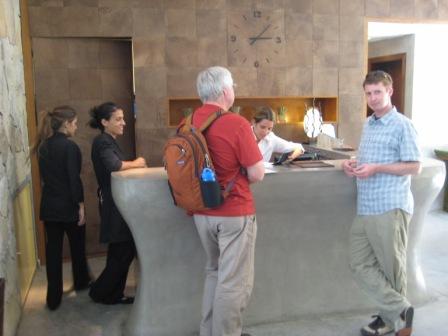 a really nice boutique hotel in the Palermo district of Buenos Aires. It is on a par with any very nice boutique hotel in Los Angeles, New York or San Francisco.
a really nice boutique hotel in the Palermo district of Buenos Aires. It is on a par with any very nice boutique hotel in Los Angeles, New York or San Francisco. 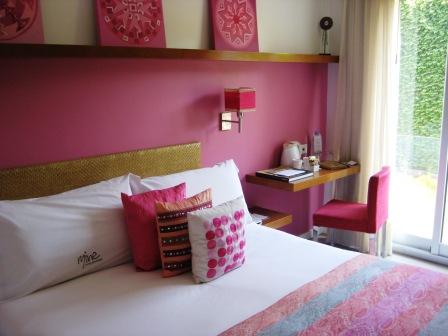 The neighborhood has great restaurants and shops. We walked to a trendy place for a 4:00 p.m. "lunch" and drinks, and then took a taxi out to a district, not too far away, where the leather clothing factories and showrooms are located. Since they actually sew the items in the back, it is not a problem to get alterations done so the item is tailored. David found a jacket that he wanted (the main purpose of our trip); Patty and I tried on various things, but did not buy anything. I found a leather sofa in the furniture section that was the same butter soft leather as David's jacket, but he said it would not fit up the stairs to his apartment.
The neighborhood has great restaurants and shops. We walked to a trendy place for a 4:00 p.m. "lunch" and drinks, and then took a taxi out to a district, not too far away, where the leather clothing factories and showrooms are located. Since they actually sew the items in the back, it is not a problem to get alterations done so the item is tailored. David found a jacket that he wanted (the main purpose of our trip); Patty and I tried on various things, but did not buy anything. I found a leather sofa in the furniture section that was the same butter soft leather as David's jacket, but he said it would not fit up the stairs to his apartment.
From there, we took a cab to the bus station so David could buy a ticket for his trip out to the beaches on the Atlantic coast. The station is about 200 yards long and lined with hundreds of bus companies selling tickets to every area of the country. Buses are the main form of transportation here and tend to be very nice, with first class airplane style, fully reclining seats for over night trips. After checking with several companies, he found one with a schedule he liked (the price being about the same) and bought the ticket. 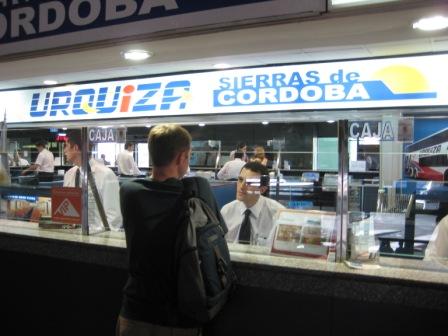 We started walking back down town around the back of the bus station until a policeman warned us that we might not come out of the neighborhood we were walking toward alive. We back tracked and took a cab to the "Florida" walking street; found a sidewalk cafe and had coffee.
We started walking back down town around the back of the bus station until a policeman warned us that we might not come out of the neighborhood we were walking toward alive. We back tracked and took a cab to the "Florida" walking street; found a sidewalk cafe and had coffee.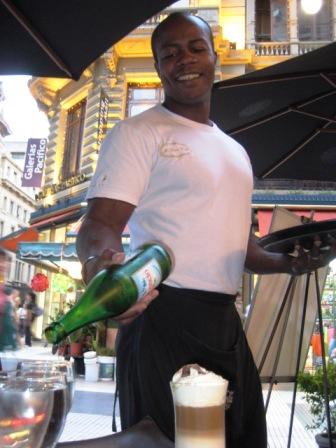
The walking streets felt a little too much like Ghirardelli Square in San Francisco for David (too touristy) and so we took a cab back to the hotel (the average cab ride being $3-6, so not a big deal.) We took one of the hotel's suggestions and went out on the edge of Palermo to an Asian Fusion restaurant in an old warehouse where they have built clubs and restaurants into the old warehouses (a little like the Cannery in Newport Beach). We sat out on a platform and had dinner outside in the balmy weather. The food was spectacular and we had a very nice dinner. It is funny that every restaurant dinner we have had, wine included comes out to about $300 pesos, or about $25 per person, regardless of the quality of the restaurant. This was by far the highest quality and the most imaginative, but the price no worse that all the others.
David left on Tuesday morning for the beach town on the bus; Patty and I are sleeping in and will then wander around the Palermo District, leaving our luggage at the hotel, until evening when we will take a cab out to the International Airport for our mid-night flight, getting us back to LAX about 9:00 a.m. on Wednesday.